Nearly every travel magazine and media outlet has included Belize in their round up of “must visit” destinations for 2012, mainly because the end of the Maya calendar takes place on December 21. And the recent visit by Prince Harry certainly did wonders for putting Belize on even more travelers’ radars.
I guess for once I was ahead of the curve on something as I’ve been traveling to Belize regularly since 2005. I already know how cool the country is. But thanks for the backup National Geographic and TIME Magazine.
Belize is a really a country that has it all for me – rich history, vibrant culture, and certainly no shortage of amazing cuisine. Those elements, along with the very special friendships I’ve made during all my trips, are the main things that bring me back at least once a year.
I’m often asked by many first-time Belize travelers which is the best Maya ruin site to visit if you only have time for one. While I certainly have not explored every Maya temple in Belize, my recommendation is visit Lamanai.
Lamanai is located in the Orange Walk District, which is in the northern part of Belize. Its name is commonly translated to “submerged crocodile”. Lamanai is one of the largest Maya sites in Belize and provides one of the more scenic trips just getting there.
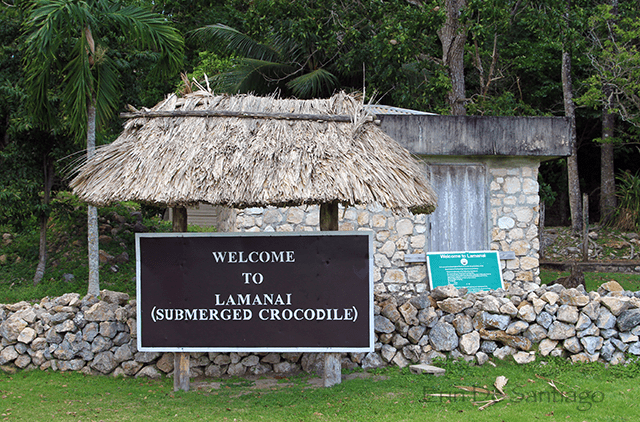
Contents
History of Lamanai
Named for the nearby once thriving population of crocodiles, Lamanai is believed to date back to 700 BC and was occupied until the 17th century AD. It was largely unexcavated until 1974, when a team uncovered much of what is seen today – which is estimated to be less than 5% of what is actually there.
Experts believe there are around 700 buildings in the complex, but thick forest has covered much of the structures that made up this Maya powerhouse of over 35,000 residents.
Maya Temples at Lamanai
If you choose to do an organized tour to Lamanai, you will likely have a bit of free time to explore the onsite museum that houses some artifacts and gives a pretty good introduction to much of what you will see at the site. Then, you have the opportunity to explore several of the excavated temples at Lamanai. Since the site has protected status, you are likely to encounter a wealth of wildlife during your tour. It’s not uncommon to see howler monkeys and toucans during your visit.
Here is an introduction to the important structures you will see at Lamanai:
Mask Temple (Structure N9-56)
Your guide will talk about the interesting history of the Mast Temple, the faces of which are cut from blocks of limestone and are said to resemble Olmec iconography from the Gulf Coast of Mexico, especially in their upturned lips and broad noses. The masks are both adorned with headdress representing a crocodile.
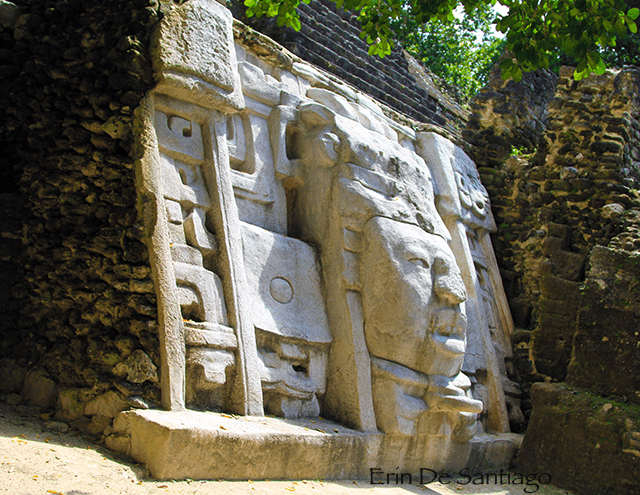
High Temple (N10-43)
This is the tallest of the temples (33 meters) at Lamanai. Most people try to climb this as the views are quite mesmerizing, but just remember the trek down may not be that easy – note the rope that many people use to help them get back down!
This temple represents a pivotal time in history as remnants of tiny houses were found below. While a shift from residential to ceremonial use is not necessarily odd, it’s the size of the temple that indicates a major change in the community prompted this statement of wealth and power.
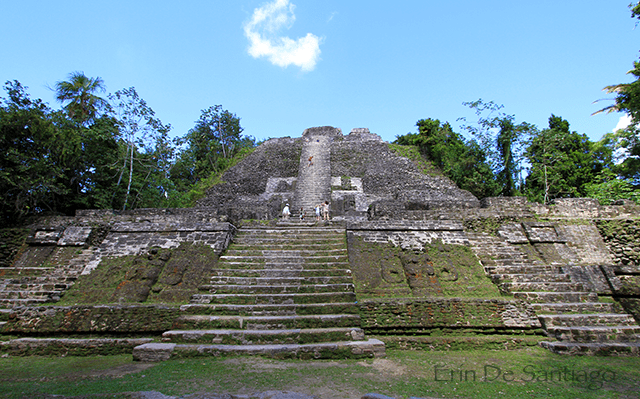
Jaguar Temple (N10-9 Complex)
This temple was built during the early Classic Period in the sixth century and saw modifications in both the eighth and thirteenth centuries. Tiny shrines at the foot of the stairs are believed to have been added in the 1400’s or later.
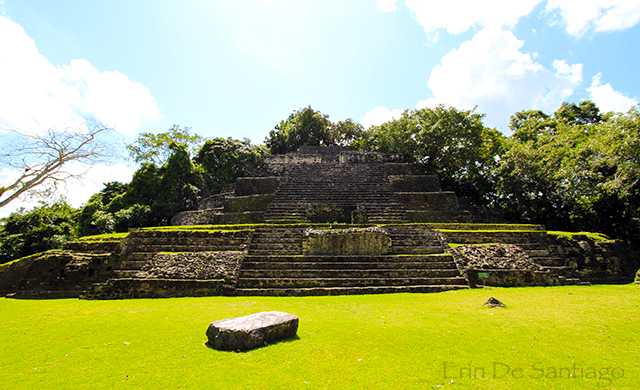
Other Notable Structures at Lamanai
Ballcourt
Although one of the smallest, the Ballcourt has the largest marker found to date. Beneath the marker, they found an offering that contained a lidded vessel resting in a pool of liquid mercury – the first discovered in the Maya lowlands.
Stela 9
This is the only monument found in the original location according to Belize’s National Institute of Culture and History. The figure depicted on the stela is Lord Smoking Shell with dates that celebrate the anniversary of his reign. Festivities took place March 7, 625 AD.
Under the stela, there is a burial that contained five children. Due to the absence of signs of violent death and the fact that children’s remains are not typically associated with the dedication of monuments, it is believed this burial had a special significance.
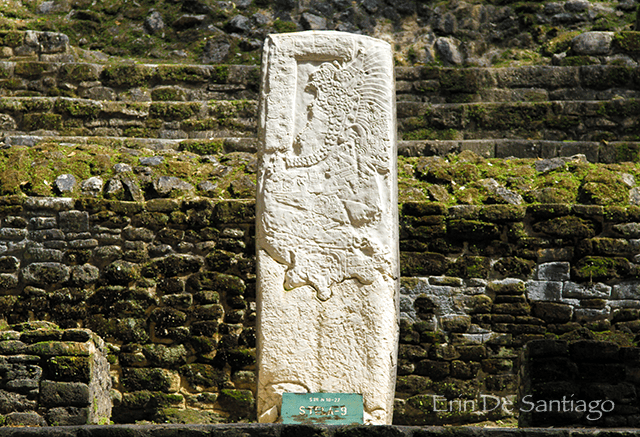
Getting to Lamanai
While you can access Lamanai by road, tour packages include a scenic 26 mile boat ride up the New River where you have the opportunity to see all kinds of animal and plant life.
Monkeys, crocodiles, various birds, interesting river fauna and more are visible during your journey up the river. The guides are pretty knowledgeable on where to find different animals – my last visit to Lamanai several weeks ago resulted in crocodile sightings and even a couple monkeys coming abroad our boat!
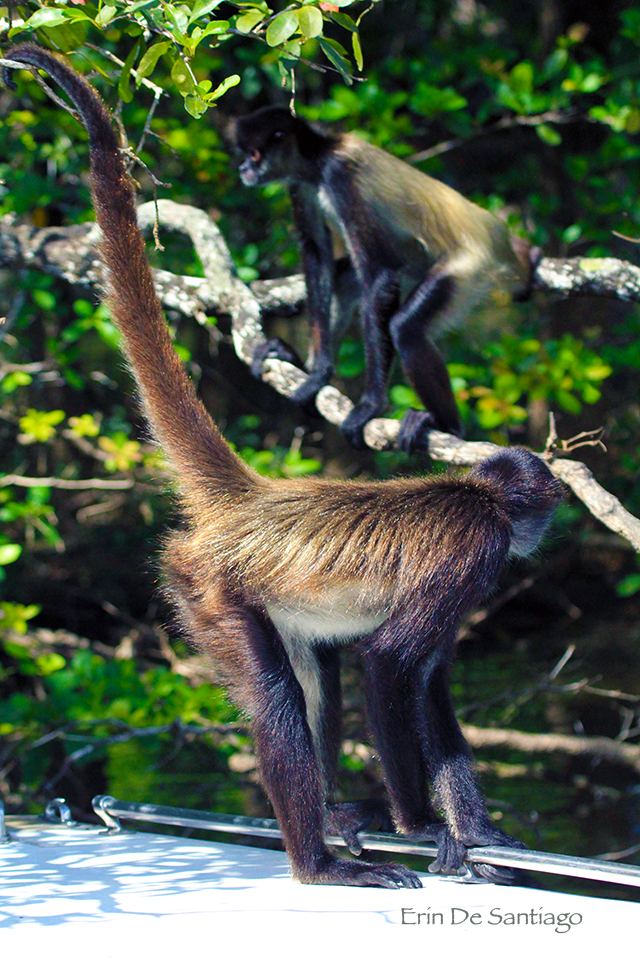
You can visit Lamanai from the Cayes as well, but it does make for a long day trip and is certainly more expensive. You are typically picked up by 7 a.m. at the latest and it’s fairly common to get dropped back off between 5 p.m. and 6 p.m. The bonus is the long boat ride and the typically endless supply of rum punch and Belikin Beer. The only downside is you may be so tired from the long day and the rum punch that you call it an early night!
